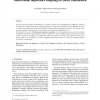Free Online Productivity Tools
i2Speak
i2Symbol
i2OCR
iTex2Img
iWeb2Print
iWeb2Shot
i2Type
iPdf2Split
iPdf2Merge
i2Bopomofo
i2Arabic
i2Style
i2Image
i2PDF
iLatex2Rtf
Sci2ools
RT
2005
Springer
2005
Springer
Bidirectional Importance Sampling for Direct Illumination
Image-based representations for illumination can capture complex real-world lighting that is difficult to represent in other forms. Current importance sampling strategies for image-based illumination have difficulties in cases where both the illumination and the surface BRDF contain important high-frequency detail – for example, when a specular surface is illuminated by an environment map containing small light sources. We introduce the notion of bidirectional importance sampling, in which samples are drawn from the product distribution of both the surface reflectance and the light source energy. While this approach makes the sample selection process more expensive, we drastically reduce the number of visibility tests required to obtain good image quality. As a consequence, we achieve significant quality improvements over previous sampling strategies for the same compute time.
Computer Graphics | Image-based Illumination | Importance Sampling | Importance Sampling Strategies | RT 2005 |
| Added | 28 Jun 2010 |
| Updated | 28 Jun 2010 |
| Type | Conference |
| Year | 2005 |
| Where | RT |
| Authors | David Burke, Abhijeet Ghosh, Wolfgang Heidrich |
Comments (0)

